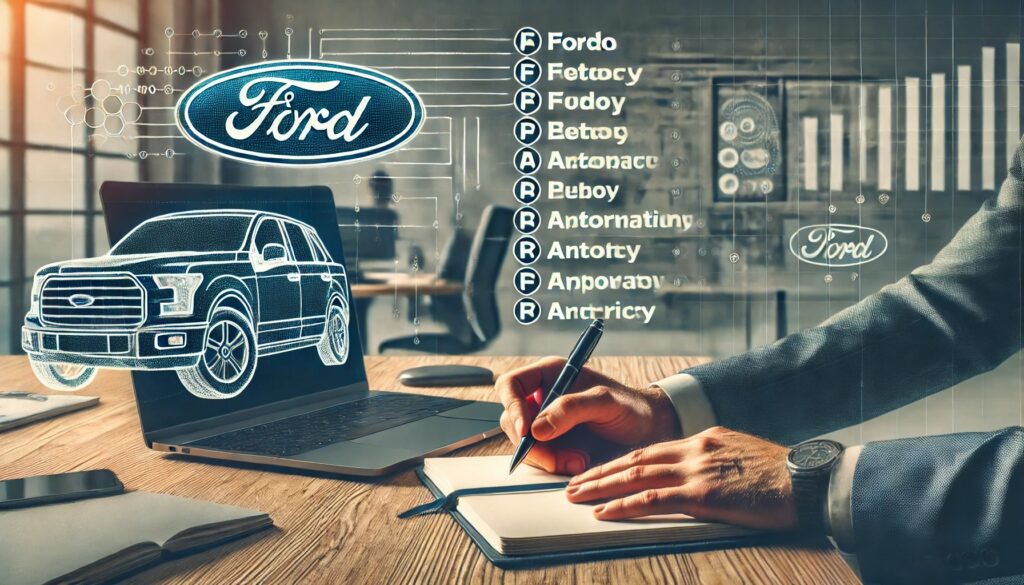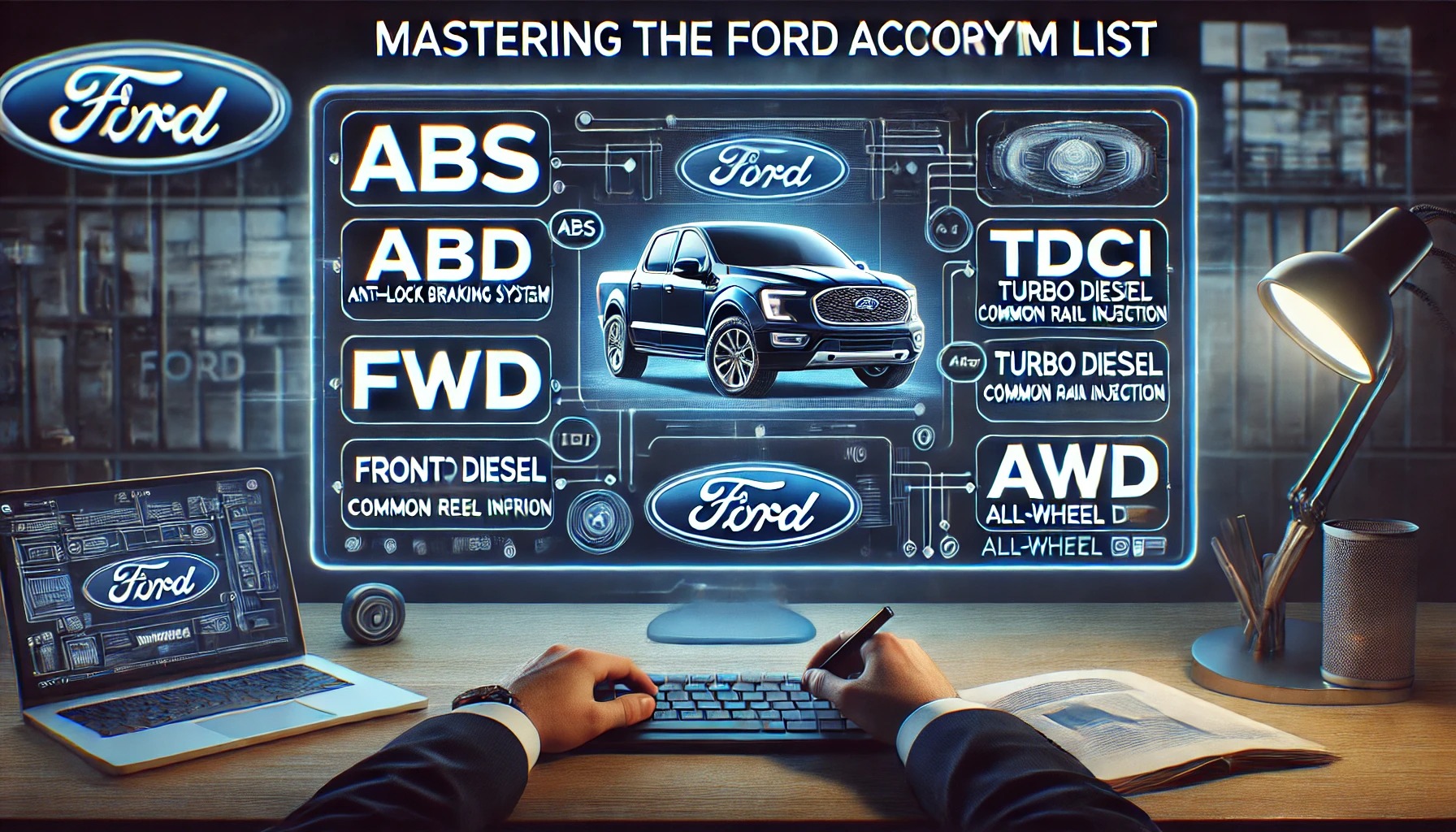Discover the essential Ford Acronym List to simplify automotive terms, boost communication, and streamline learning for employees and car enthusiasts. From ABS to TDCi, this guide decodes features and technologies for better understanding and usage. Stay updated and enhance your automotive knowledge effortlessly!
Stay tuned with us as we dive into “Mastering the Ford Acronym List – A Helpful Guide for Employees and Enthusiasts.” We’ll explore how these acronyms simplify automotive terms, enhance communication, and make understanding Ford technologies a breeze. Don’t miss out!
What Is The Ford Acronym List?
The Ford Acronym List is a collection of short forms (acronyms) used by Ford to make long words or phrases easier to say and understand. These acronyms are used to describe car features, engine types, technology, or even work processes.
For example:
- ABS: Anti-lock Braking System (a safety feature that prevents tires from skidding).
- FWD: Front-Wheel Drive (the car’s front wheels do the driving).
- TDCi: Turbo Diesel Common Rail Injection (a type of powerful and fuel-efficient engine).
This list helps Ford employees, mechanics, and car owners quickly understand technical details without needing long explanations. It’s like a shortcut language for cars and how they work!
What Are Some Examples Of Technical Acronyms Used By Ford?
Ford vehicles utilize many technical acronyms that describe various features and systems. Here are some examples explained in simple terms:
Common Technical Acronyms
- ABS (Anti-lock Braking System): This system prevents the wheels from locking up during hard braking, helping the driver maintain control.
- AWD (All-Wheel Drive): A system that sends power to all four wheels of the vehicle, improving traction and stability, especially in slippery conditions.
- FWD (Front-Wheel Drive): In this setup, the engine’s power is sent to the front wheels, which helps with fuel efficiency and handling.
- ECU (Engine Control Unit): This is the computer that manages engine performance, including fuel injection and ignition timing.
- ESP (Electronic Stability Program): A safety feature that helps prevent skidding and loss of control by adjusting the brakes and engine power when needed.
- DTC (Diagnostic Trouble Code): Codes generated by the vehicle’s computer when it detects a problem, helping mechanics diagnose issues.
- EGR (Exhaust Gas Recirculation): A system that reduces emissions by recirculating a portion of the exhaust back into the engine for cleaner combustion.
- TDCi (Turbo Diesel Common Rail Injection): A type of diesel engine technology that improves fuel efficiency and reduces emissions by injecting fuel directly into the combustion chamber.
Are There Humorous Versions Of The Acronym “Ford”?
Yes! People like to joke about what “FORD” stands for, and they’ve come up with some funny meanings. Here are a few:
- Fix Or Repair Daily: A joke about needing to fix the car often.
- Found On Road Dead: A funny way of saying the car might break down.
- Fossilized Old Reeking Disaster: A playful way to make fun of old or worn-out Ford cars.
These jokes are just for fun and not meant to be taken seriously!
How Can I Use The Ford Acronym List In Practice?

You can use the Ford Acronym List in several practical ways, especially If you’re involved with Ford vehicles or the automotive industry. Here’s how:
Understanding Vehicle Features
When you see acronyms in manuals or specifications, you can refer to the list to understand what they mean. For example, knowing that AWD stands for All-Wheel Drive helps you understand a vehicle’s traction capabilities.
Effective Communication
If you’re discussing Ford vehicles with mechanics, salespeople, or other enthusiasts, using acronyms correctly can help you communicate more effectively. It shows familiarity with the brand and its technologies.
Troubleshooting Issues
Many acronyms relate to specific systems or components of a vehicle. If you encounter a problem, knowing terms like DTC (Diagnostic Trouble Code) allows you to better understand what might be wrong and how to fix it.
Learning and Training
If you’re new to automotive technology or working at Ford, the acronym list serves as a learning tool. It can help you familiarize yourself with industry terminology quickly.
Enhancing Customer Service
If you’re in sales or customer service, understanding acronyms allows you to explain features and benefits clearly to customers, enhancing their experience and trust in your knowledge.
Reference for Documentation
When writing reports or documentation related to Ford vehicles, including relevant acronyms can make your writing clearer and more professional.
Are Commercial Ford Acronyms Different From General Ones?
Yes, commercial Ford acronyms are different from general ones. Here’s a simple explanation:
Differences Between Commercial and General Ford Acronyms
Purpose:
- Commercial Acronyms: These are specifically used for Ford’s commercial vehicles, like vans and trucks. They focus on features important for businesses, such as cargo capacity and vehicle configurations.
- General Acronyms: These apply to all Ford vehicles, including cars and SUVs, and cover a wider range of features like engine types, safety systems, and technology.
Examples:
- Commercial Acronyms:SCC
- General Acronyms:ABS
Usage Context:
- Commercial Acronyms are often used by businesses that need specific types of vehicles for work, focusing on things like load capacity and vehicle layout.
- General Acronyms are used by everyday drivers, mechanics, and enthusiasts discussing features relevant to all types of Ford vehicles.
Does Ford Update Its Acronyms?
Yes, Ford regularly updates its acronyms to keep them relevant and accurate as new technologies and vehicle features are introduced. When Ford develops new systems, engines, or safety features, they often create new acronyms to describe these innovations. Over time, older acronyms may also be updated or replaced to reflect improvements or changes in technology. This helps keep the list of acronyms current, ensuring that everyone—whether it’s employees, mechanics, or car buyers—can easily understand the latest Ford vehicles and their features.
Where Can I Find A Comprehensive Ford Acronym List?
You can find a complete Ford Acronym List in a few places:
- Ford Wiki: This is a website where you can search for Ford-related terms and acronyms.
- Scribd: Some documents on this platform share lists of Ford acronyms, and you can download them.
- Ford’s Internal Systems: If you work for Ford, they may have the list in their internal documents or databases.
Why Is The Ford Acronym List Critical For Employees?
The Ford Acronym List is usually not very critical for employees because it helps them communicate clearly and quickly using the same language. Ford uses a lot of technical terms, and having a list of acronyms makes it easier for workers to understand and talk about car features, parts, and processes. It also helps new employees learn the common terms they’ll need to know for their job, making it faster for them to get up to speed and work efficiently. In short, the list keeps everyone on the same page.
Are Ford Acronyms Used Industry-Wide?

Ford acronyms are primarily used within the company and its specific context, but some of them can also be found in the broader automotive industry. Here’s a simple explanation:
- Company-Specific Acronyms: Many acronyms are unique to Ford and relate specifically to their vehicles, systems, and processes. For example, terms like TDCi (Turbo Diesel Common Rail Injection) are specific to Ford’s diesel engines.
- Industry-Wide Usage: Some acronyms, especially those related to general automotive technology, are used across the industry. For instance, acronyms like ABS (Anti-lock Braking System) and FWD (Front-Wheel Drive) are common in many car brands, not just Ford.
- Commercial Vehicle Acronyms: Ford has specific acronyms for its commercial vehicles that may not be widely used outside of their context. For example, terms like DCC (Double Chassis Cab) are relevant mainly to Ford’s commercial vehicle line.
- Learning and Training: Employees in the automotive industry may learn about Ford-specific acronyms during training or when working with Ford vehicles. However, they will also encounter general automotive acronyms that apply to all brands.
How Can I Access A Ford Acronym List Pdf?
To access a Ford Acronym List in PDF format, you can follow these simple steps:
- Visit Online Resources: You can find PDF versions of the Ford Acronym List on various websites. One option is to go to PDF Coffee where they offer a downloadable booklet containing Ford acronyms and definitions
- Check Archive Websites: Another option is to look for the list on archive sites like the Internet Archive. They often have older versions of documents, including Ford’s acronym lists. You can search for “Ford Speak Acronyms” there to find relevant PDFs.
- Download Directly: Once you find the PDF you want, simply click on the download link provided on the website. Make sure you have a PDF reader installed on your device to open it.
- Use Company Resources: If you are an employee at Ford, you might also have access to the Ford Intranet where the most current acronym list is available. You can check there for the latest updates.
Do Other Manufacturers Have Similar Acronym Lists?
Yes, other manufacturers do have similar acronym lists, just like Ford. Here’s a simple explanation:
Common Practice: Many car manufacturers use acronyms to describe their technologies, features, and systems. This helps simplify communication about complex topics.
Examples from Other Brands
- Toyota: They have acronyms like VVT-i (Variable Valve Timing with intelligence), which helps improve engine performance and fuel efficiency.
- Mercedes-Benz: They use acronyms such as 4MATIC, which refers to their all-wheel-drive system, and AMG, which is their performance division known for high-speed cars.
Industry-Wide Usage: Acronyms like ABS (Anti-lock Braking System) and FWD (Front-Wheel Drive) are common across many brands, not just Ford. These terms are widely recognized in the automotive industry.
Accessing Lists: Just like Ford’s acronym list, other manufacturers often provide their lists on their official websites or in user manuals, making it easy for customers and employees to understand the terminology.
FAQs
1. What makes Ford acronyms unique compared to other manufacturers?
Ford acronyms often combine technical details with user-friendly shorthand, tailored to specific systems like TDCi engines or chassis configurations, setting them apart from standard industry terms.
2. How can Ford acronyms benefit new automotive employees?
The Ford Acronym List serves as a quick-reference tool, helping new employees learn technical terms and company-specific jargon, improving their efficiency and communication.
3. Are Ford acronyms relevant for car buyers?
Yes, Ford acronyms help car buyers understand vehicle features, such as AWD for All-Wheel Drive, making it easier to compare models and choose the right vehicle.
4. How does Ford ensure its acronyms remain up-to-date?
Ford continuously updates its acronym list to reflect new technologies, vehicle specifications, and industry advancements, ensuring relevance and clarity in communication.
Conclusion
Mastering the Ford Acronym List is a valuable skill for both employees and enthusiasts, offering a deeper understanding of Ford’s technical terms, vehicle systems, and unique features. This guide simplifies complex automotive jargon, making it easier to communicate effectively, troubleshoot issues, and explore Ford’s innovative technologies. Whether you’re new to the industry or a seasoned enthusiast, decoding these acronyms enhances your knowledge, boosts confidence in discussions, and ensures you stay informed about Ford’s latest advancements. Embrace the power of this guide to navigate the automotive world with ease and expertise.
